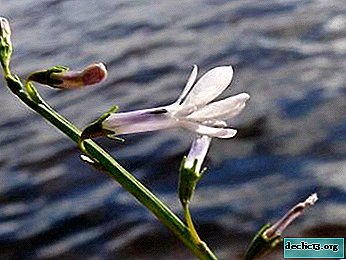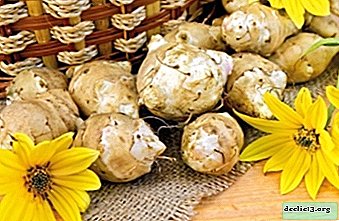Features of the care and cultivation of Sansevieria Hanni, a description of her subsorts and their photos

Growing flowers at home is a good way to improve the interior and decor of your home. You can buy ready-made plants in a specialized flower shop, but you can grow a beautiful and well-formed plant yourself.
Read on where the flower comes from, as it is also called, its subcortex. How to care for it at home, what are the ways of reproduction, how it blooms. And also what diseases and pests should the florist be afraid of, what to look for when examining a flower.
Botanical Description
Sansevier (lat. Sansevieria) - is a genus of perennial herbaceous plants that belong to the asparagus family (Asparagaceae). Biologists used to attribute them to the agave family. These representatives of the flora grow in arid conditions of the subtropical and tropical zones of Africa. Sansevierra grows on the island of Madagascar, in southern Asia, as well as in the United States. In total there are more than 60 varieties of sansevieria.
The name of this genus of plants in Russia does not always indicate the same: sansevier, sansevieria, sansevier. There are also popular names: "pike tail", "mother-in-law's tongue", "snake skin". In the UK, it is called "tiger lily."
The genus is named after the Italian prince Sanseviero, who studied botany and was an outstanding philanthropist. Sanseviera began to be grown in Europe in the 18th century.In 1941, the scientist and plant breeder S. Khan bred a new undersized (up to 30cm high), rosette variety of sansevier, which was given the name in honor of its creator: hanni (sansevieria hahnii). The original variety was Sanseviera Laurenti.
Podsorta Hahnii and their photos
Sansevier hanni (sansevieria hahnii) is a compact and small plant. Its height usually does not exceed 30 cm. The leaves grow from a rosette in the shape of a vase and have a dark green color.
The list of Hanni species is presented below.
Golden (Golden)
The rosette of the plant is similar to the main variety, the difference is the golden longitudinal stripes. A variety of Sanseviera Gold was developed in 1953 by S. Khan.

Kristata
It resembles the main variety in leaf color, but has a pronounced tendency to wrap the edges of the leaf toward the center, which is why the leaves fold almost along in half.

Silver (silver)
It is similar in shape to the main variety, but the color of the leaves has a silvery sheen. On the leaves there is a dark border and transverse stripes.

Home Care
- Temperature. In the spring-summer period, a temperature of 18-25 ° C is needed. In the autumn-winter period, the temperature for a long time should not be lower than 14-16 ° C. With a prolonged decrease in temperature, the plant can become sick and die.
- Watering. You need moderate soil moisture from spring to autumn. In winter, watering is limited, depending on the room temperature. When watering, especially in the cold season, it is unacceptable that water gets into the center of the outlet - this can lead to decay of the plant.
- Lighting. Bright diffused lighting is most suitable. The plant tolerates both light partial shade and full shadow. You need to know that for variegated sansevieri you need bright and intense lighting, because when grown in the shade, the bright color of the leaves is lost.
- The soil. The composition of the soil for the cultivation of sansevier hanni:
- 2 parts of turf land;
- 1 part of leafy soil;
- 1 part humus;
- 1 part peat;
- 1 part of sand.
- The use of fertilizers. During the growing season (spring-summer), mineral fertilizers (half concentration) are used once a month. Fertilizers for cacti are best suited.
Attention! When the plant is in a dark place, the number of top dressings should be reduced.
- Pot. This plant has a very powerful root system, so you need to buy a thick-walled clay pot, because a plastic one can crack under the strong pressure of the roots. The pot should be wide and shallow.
- Plant transplant. The main indicator of the need for a transplant is the appearance of roots from the holes on the bottom of the pot. It is not necessary to transplant the plant infrequently.
 for transplantation, it is necessary to purchase soil, expanded clay in advance;
for transplantation, it is necessary to purchase soil, expanded clay in advance;- then remove the plant from the old pot without damaging the root system;
- then the plant needs to be moved to a new pot, in which there is already drainage, add soil;
- then pour.
- Pruning. This process is not difficult. You just need to remove the old pouring, as well as those that have lost their decorative appearance. You can also trim dry leaf tips.
- Wintering. Wintering plants should take place in room conditions. The main thing is to prevent waterlogging of the soil and the location of the plant at low temperatures.
From the form you will learn how to care for the Sansevieria Hanni at home:
Breeding
- Plant seeds are in the pod. The berries must be allowed to dry without being removed from the natural shell, and then planted in ordinary plastic pots with soil. The best place for germinating seeds is a greenhouse.
- The division of the rhizome occurs as follows: first you need to remove the root system from the soil, then rinse it carefully, and then cut it with a knife, separating the root system along with the leaves, and plant it in a new pot with a substrate.
This process is best done in early spring so that new plants can get stronger by winter. A separate root system requires: moisturizing, lighting and top dressing.
- Cutting leaves is a rather complicated procedure. First you need to cut the whole sheet into several 6 cm pieces and mark the bottom. Then you need to wait a few days. After the leaves have dried, they need to be planted in a pot with sandy soil no deeper than 2 cm. It takes about 6 weeks for rooting to take place. After this, the plant is planted in a pot with soil.
On a note. This type of reproduction has a major drawback - the process can damage the quality of the plant, so this method is rarely used.
Bloom
When flowering, the plant releases an oblong arrow, on which there are small flowers with drops of nectar under them. The aroma of flowers is tender. A feature of flowering is the blooming of flowers at a late time of the day. Usually flowering occurs in April or May.
Diseases and Pests
 Sanseviera Hanni is resistant to almost all diseases and pests of indoor plants. Only immoderate moistening or pouring water into leaf sockets can destroy it.
Sanseviera Hanni is resistant to almost all diseases and pests of indoor plants. Only immoderate moistening or pouring water into leaf sockets can destroy it.
It is extremely rare that a plant is affected:
- Spider mite.
- Thrips.
- Mealybug.
- Anthracnose.
Similar flowers
- Zamioculcas;
- Crassula;
- Aspidistra;
- Hoya
- Chlorophytum;
- Kalanchoe.
Competent agricultural technology, knowledge of the characteristics of this plant and attention will allow you to grow an excellent sansevier hanni at home.

 for transplantation, it is necessary to purchase soil, expanded clay in advance;
for transplantation, it is necessary to purchase soil, expanded clay in advance;















